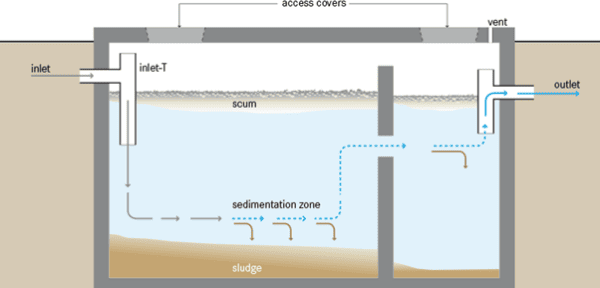Off – Mains Sewerage.

Over a million properties across rural areas of the UK cannot connect to the main sewerage infrastructure and must use an alternative for foul drainage.
There are various options for off-mains sewerage, although the Regulations that came into force on 1 January 2015 regarding general binding rules and soakaways, mean a septic tank is not always the easier option now. A summary of the General Binding Rules for small sewage discharges can be found here.
Septic Tank

A septic tank is underground and waste flows to the tank for basic treatment, the solids settle on the bottom and the scum will float. There will be anaerobic digestion of the solids reducing the volume that must be removed, whilst the relatively clear water is discharged in to a drainage field. For the average household the tank will need to be emptied once a year. The treated water will either be discharged to the ground or to surface water and there are different regulations for each.
The 2015 General Binding Rules: small sewage discharge to a surface water mean that any existing system that discharges directly to surface water must be replaced by a small sewage treatment plant by 2020 and “responsibility for the replacement or upgrade of the existing treatment system should be addressed between the buyer and seller as a condition of sale.” Although if the Environment Agency find that the septic tank is causing pollution the replacement or upgrade would have to be carried out within 1 year.
Cesspool (or Cesspit)

Unlike the septic tank, the cesspit does not drain away any of the water materials, the waste is simply collected and held in the massive (~18,000 L for a 3 bedroom house) tank. As there is no soakaway, the tank must be emptied regularly, literally the waste sucked out into a tanker and driven away. For an average household, these need to be emptied around 16 times a year. They are banned in Scotland and installed as a last resort where a septic tank or treatment plant would not be possible due to a lack of a watercourse, high winter water table, location in a Ground Water Protection Zone or the wrong type of soil for a drainage field (the soil needs to be able to absorb a certain volume of water to be suitable).
Sewage Treatment plant

A sewage treatment plant is a mechanical system that will treat the waste liquid so that its clean enough to be discharged into a river or stream. This is normally a 3-part process with a primary settlement chamber (like a traditional septic tank) allowing the waste to separate out into sludge, liquid and scum. The liquid effluent then passes into the biozone where it is biologically treated using a filter bed, rotating disc media or air injection. There is then a final settlement stage to remove the fine solids. As with a septic tank the ‘sludge’ needs to be removed, usually annually.